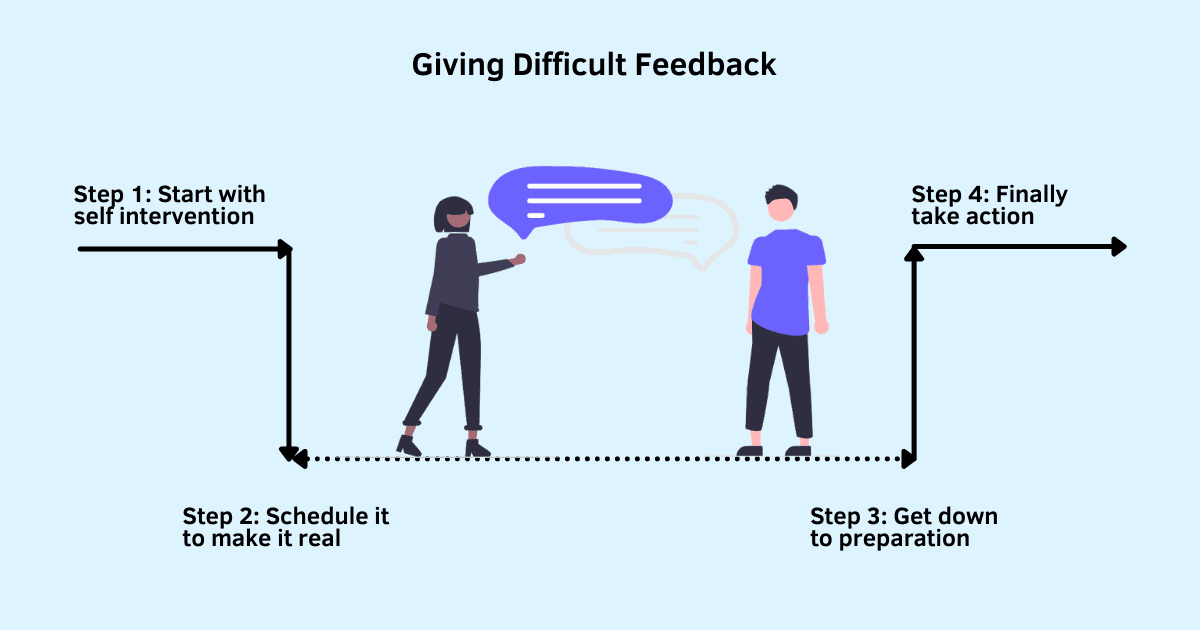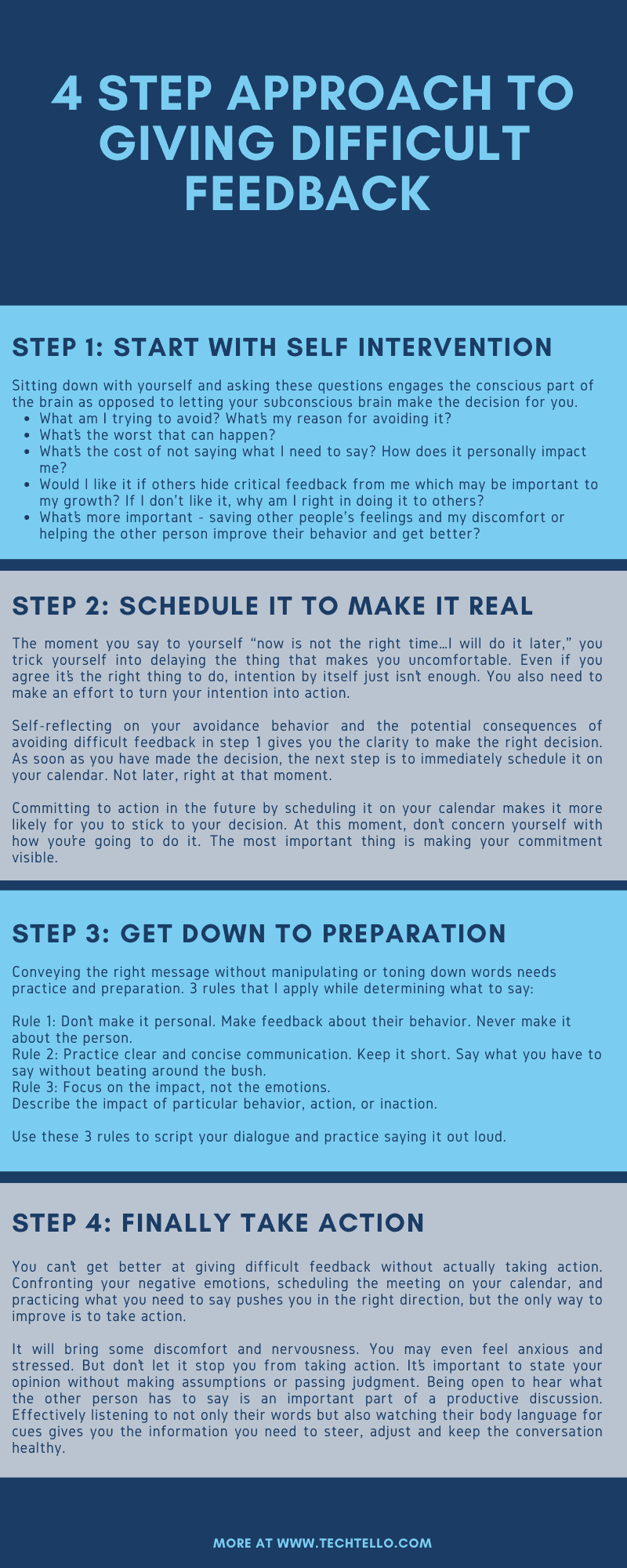How To Be Comfortable Giving Difficult Feedback

What’s more dreadful than receiving difficult feedback? Giving one. Worried that negative feedback will hurt the other person and ruin your relationship is one of the biggest deterrents to avoid saying what you need to say.
What if it’s the feedback you need to give to someone senior in your organization – a leader from another department, your CTO, your own boss? Would you feel comfortable telling them how exactly you feel?
In my experience, most people don’t. We either ignore it by telling ourselves a lie “It’s not that important” or try to delay it waiting for the perfect opportunity to strike, which never really does.
Not saying what you need to say makes you avoid the person, causing more stress and anxiety than you would have if you had simply found the courage to face the person. Repeating the tape in your mind on what you are going to say, anticipating their response, and imagining the worst possible outcome makes it all the more harder. Every rewind makes the story more and more dreadful, convincing you that you are right in not speaking up and telling the truth isn’t worth the risk.
Not speaking up does not save your relationship with the other person, it only hurts it more. You start being awkward around them. Actively avoiding what you need to say makes you put on a show. Distracted by the chatter going on in your mind makes you focus less on the discussion and more on how you are coming across to them “Will they know how I feel if I say this?” “How can I hide my feelings?” “What if my feelings are obvious to them?”
Here’s another problem. Not having the difficult conversation does not make the problem disappear, it only makes it worse. You not only hate yourself for doing nothing about it, you secretly start hating the other person too. And all this, while they have absolutely no freaking idea of these negative feelings.
If it’s an issue that matters to you, the impact of avoiding the difficult conversation isn’t just limited to hurt feelings, it hurts your productivity and performance too.
Avoiding the conversation doesn’t help you. It definitely doesn’t help the other person. The momentary discomfort you save by avoiding the difficult conversation only gets magnified over a period of time.
Giving difficult feedback is the most difficult thing you may have to do at work, but building this skill is like building muscle. It only gets better with practice. It never gets easy, you only get better.
Hal Elrod, author Miracle Morning says “Every result you want in your life is proceeded by a process. You need to define and implement your process. Affirm that and now you are getting somewhere.”
Here’s my step-by-step process that has worked for me to give difficult feedback.
4 step approach to giving difficult feedback
Step 1: Start with self intervention
Daniel Kahneman writes in Thinking, Fast and Slow “Many of the options we face in life are mixed: there is a risk of loss and an opportunity for gain, and we must decide whether to accept the gamble or reject it…When directly compared or weighted against each other, losses loom larger than gains.”
This loss aversion and excessive focus on the negative makes you reject the potential gain in speaking up while fixating on the harm of doing so.
The only way to embrace giving difficult feedback is to engage in deliberate thinking, starting with self intervention.
Sitting down with yourself and asking these questions engages the conscious part of the brain as opposed to letting your subconscious brain make the decision for you.
- What am I trying to avoid? What’s my reason for avoiding it?
- What’s the worst that can happen? Is it really going to be this bad or am I making things up?
- What’s the cost of not saying what I need to say? How does it personally impact me?
- Would I like it if others hide critical feedback from me which may be important to my growth? If I don’t like it, why am I right in doing it to others?
- What’s more important – saving other people’s feelings and my discomfort or helping the other person improve their behavior and get better?
These questions may take some time initially, but with enough practice, you automatically learn to embrace difficult conversations and instinctively find yourself less intimidated.
Master Difficult Conversations
Engage in healthy dialogue, build stronger relationships and achieve a better outcome.
Step 2: Schedule it to make it real
The moment you say to yourself “now is not the right time…I will do it later,” you trick yourself into delaying the thing that makes you uncomfortable. Even if you agree it’s the right thing to do, intention by itself just isn’t enough. You also need to make an effort to turn your intention into action.
Nir Eyal writes in Indistractable “We must learn a powerful technique called a precommitment, which involves removing a future choice in order to overcome our impulsivity…Such precommitments are powerful because they cement our intentions when we’re clearheaded and make us less likely to act against our best interests later.”
Self-reflecting on your avoidance behavior and the potential consequences of avoiding difficult feedback in step 1 gives you the clarity to make the right decision. As soon as you have made the decision, the next step is to immediately schedule it on your calendar.
Not later, right at that moment. Committing to action in the future by scheduling it on your calendar makes it more likely for you to stick to your decision. At this moment, don’t concern yourself with how you’re going to do it. The most important thing is making your commitment visible.
Once you complete this step, you’ve already won half the battle. The next step is about not letting your discomfort and nervousness get in the way of delivering difficult feedback.
Step 3: Get down to preparation
Chris Voss writes in Never Split the Difference “Prepare, prepare, prepare. When the pressure is on, you don’t rise to the occasion; you fall to your highest level of preparation.”
Unless you are already someone who’s good with difficult conversations, entering into a discussion without preparation will make you say things you will most likely regret later. Conveying the right message without manipulating or toning down words needs practice and preparation.
Here are the 3 rules that I apply while determining what to say:
Rule 1: Don’t make it personal. Make feedback about their behavior. Never make it about the person.
For example, there’s a huge difference between telling someone “You’re dominating” vs saying “When you do [this, this and that], it makes us think that you don’t care about our opinions.”
The first one will immediately put the other person on the defensive while the second one gives them an opportunity to evaluate your opinion.
Rule 2: Practice clear and concise communication. Keep it short. Say what you have to say without beating around the bush. You need to be specific to help them understand your concern without drowning them in unnecessary information. Typically, an example or two where you saw the troubling behavior in action should be sufficient to help them connect and make sense of the discussion.
For example, if your manager has a tendency to call late in the night which disturbs your evening time with your family, don’t blabber about it and push the responsibility to them to read between the lines and make sense of your hidden problems. Be straight and talk openly about the inconvenience. Tell them how their calls in the night make it difficult for you to spend quality time with your family and why you need that downtime to give your best and make a productive contribution.
Rule 3: Focus on the impact, not the emotions.
Describe the impact of particular behavior, action, or inaction. Speaking about the impact engages a portion of the brain that makes them actively seek solutions as opposed to making it about the emotions which inhibit their ability to think logically and makes it difficult for them to rationalize the situation.
For example: If a coworker has the habit of using offensive language at work, instead of telling them how their language makes you feel, tell them how it impacts your collaboration. It does not mean that you disregard your feelings and shouldn’t mention them at all. However, keeping the focus on the impact while adding emotions to the mix to guide the conversation is a super effective strategy to gain control of the situation and engage them with the intent of finding a mutually agreeable solution.
Use these 3 rules to script your dialogue and practice saying it out loud.
Step 4: Finally take action
Zig Ziglar writes “You don’t have to be great to start, but you have to start to be great.”
In other words, you can’t get better at giving difficult feedback without actually taking action. Confronting your negative emotions, scheduling the meeting on your calendar, and practicing what you need to say pushes you in the right direction, but the only way to improve is to take action.
It will bring some discomfort and nervousness. You may even feel anxious and stressed. But don’t let it stop you from taking action. Acknowledge what you’re feeling and nicely tell your thoughts to step aside and make way for doing the right thing – “I know that I am feeling [this, this, and that], but for now I need to focus my energies on this conversation.”
It’s important to state your opinion without making assumptions or passing judgment. Being open to hear what the other person has to say is an important part of a productive discussion. Effectively listening to not only their words but also watching their body language for cues gives you the information you need to steer, adjust and keep the conversation healthy.
Master the Art of Active Listening
Elevate your listening abilities, enhance your personal and professional relationships, and achieve greater career success.
A great way to end the discussion is to show your curiosity and tell them how much you would appreciate it if they would also share constructive criticism.
Whenever you find yourself delaying difficult feedback or actively avoiding it, start with self intervention, schedule the meeting on your calendar, practice saying it right, and just go ahead and do the thing.
Summary
- Giving difficult feedback does not impact your relationship with the other person. Not saying what you need to say does.
- It’s never easy to share constructive criticism. You may be tempted to save a little discomfort in the moment, but temporary relief from the problem does not make it disappear. It only brings a lot of stress and anxiety later.
- To get better at giving difficult feedback, go and actually do the thing. It won’t get easy, you will only get better.
- To give difficult feedback, start with self intervention. Instead of letting your brain run on autopilot and avoid the difficult conversation, pause and take time to question yourself making it more likely for you to make the right decision.
- Consciously choosing to do the right thing is a good first step. The next step is to schedule it on your calendar making it more likely for you to stick to that decision.
- There’s a right and wrong way to give difficult feedback. Keep your message effective by knowing what you need to say and practice saying it loud.
- Finally, go ahead and do the thing. To keep the conversation productive, don’t pass judgment, only share your opinion. Guide the conversation in the right direction by giving them an opportunity to speak up and practicing active listening.































